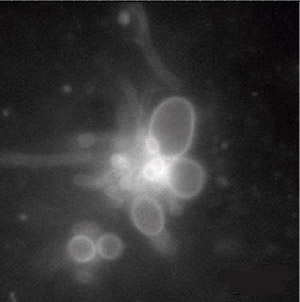Cell membranes self-assemble
Published Date
By:
- Susan Brown
Share This:
Article Content
A self-driven reaction can assemble phospholipid membranes like those that enclose cells, a team of chemists at the University of California, San Diego, reports in Angewandte Chemie.

Spontaneously assembled membranes. Credit: Devaraj Lab
All living cells use membranes to define physical boundaries and control the movement of biomolecules. Movement of molecules through membranes is a primary means of sending signals to and from cells.
Neal Devaraj, a chemistry and biochemistry professor at UC San Diego, leads a research team that develops and explores new reactions that can trigger the formation of membranes, particularly the spheres that characterize membranes that enclose vesicles and cells.
The new process they have just described is specific and non-toxic, and can be used in the presence of biomolecules one might want to study within artificial cells. The technique could also be used to assemble packets for drug delivery.
Natural cells use enzymes to catalyze the biochemical reactions that manufacture their membranes from thioester precursors, but in this case Devaraj's team was able to get membranes to assemble spontaneously, without enzymes, through a process called native chemical ligation.
"This is the first report to my knowledge of nonenzymatically forming phospholipid membranes from thioester precursors," Devaraj said. "This mimics the membrane-protein-catalyzed assembly of phospholipids in live cells, which also uses long-chain thioesters as precursors."
Co-authors include postdoctoral researcher Roberto Brea and graduate student Christian Cole. This work was funded by a grant through the MURI program, U.S. Army Research Office and the National Science Foundation. Brea is a Cross-Disciplinary Fellow in the Human Frontier Science Program. Cole is supported through a National Institute of General Medical Sciences training grant.
Share This:
You May Also Like
UC San Diego is Strengthening U.S. Semiconductor Innovation and Workforce Development
Technology & EngineeringStay in the Know
Keep up with all the latest from UC San Diego. Subscribe to the newsletter today.



